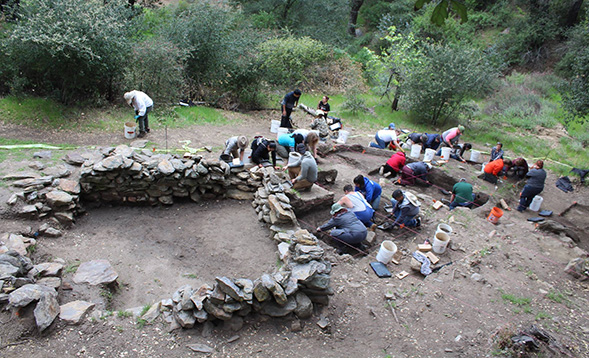Bones and Broken Bottles
Natalia Galeana is one of dozens of SDSU students digging their way to a dream career.

Since early February, Natalia Galeana awakes at 4:30 a.m. every Saturday mornings, dresses in layers, gathers her excavation gear and heads from her Chula Vista home to a parking lot at San Diego State University. There she boards a van bound for Palomar Mountain with fellow students from Anthropology 312: Archeological Field Methods and Anthropology 560: Advanced Archeological Field Methods.“I want them to engage in real archaeology. I want them to do each part of the process of discovery: the digging, screening, mapping, photographing, recording, and analyzing.”
By 10 a.m., the group is digging at the homestead site of Nate Harrison, a legendary San Diego County pioneer. Born a slave in Kentucky, Harrison was the first African-American settler in the area. Archaeological digs at the property yield treasure troves of fascinating artifacts ranging from broken bottles to fired rifle cartridges and tobacco cans—all providing historical and cultural insight.
“I like digging and finding bones, and we have a lot of bones here at the site.” said Galeana, a senior anthropology major whose employment interests include forensic anthropology.
It’s hard and dirty work, but Galeana likes it so much she spent five days during spring break this semester camped on the mountainside with 24 other students from Anthropology 495: Internships in Anthropology. The field school, led by anthropology professor Seth Mallios, provides valuable experience outside the classroom for students who, like Galeana, hope to launch professional careers.
"I want them to engage in real archaeology,” Mallios said. “I want them to do each part of the process of discovery: the digging, screening, mapping, photographing, recording, and analyzing.
“It's too easy to fall in love with one part of the archaeological process and to ignore all the other things that you need to be accountable for as well. So I want this to be a real, honest excavation experience that gives them all of that."
Professional payoff
The payoff can be much more than an interesting educational experience, as Alexia Landa has discovered. After graduating in December with a double major in history and anthropology, the 32-year-old U.S. Navy veteran found employment with the California State Parks as an archaeological specialist and with PanGIS, a company that provides environmental compliance services for cultural and environmental resources and land planning projects.In applying for the jobs, Landa listed a previous field school experience on her resume along with her plans to participate in the Nate Harrison site dig. “They picked me up right away,” she said.
Both the National Historic Preservation Act and the California Environmental Quality Act contain provisions requiring certain protections of sites deemed historically, environmentally or culturally significant. Disturbance of such a site for any reason often requires analysis by an archaeologist.
“Whether it is taking out sewer lines or installing a new telephone pole, you always have to have an archaeologist present in case cultural material pops up and then if it is something significant we are supposed to stop the work,” said Landa. "In the state parks it's similar; whenever they are doing any kind of trail modification or building a new restroom or visitors center, we have to be present.”
In demand
Mallios said there are 30,000 such sites in San Diego County. SDSU is one of just a handful of local institutions offering the field school training students need to gain experience to land jobs at those sites."There are very few (institutions offering field schools) and what the counterbalance is, there are 50 different cultural resources management firms in San Diego County that employ our archaeologists,” Mallios said. “There is work because San Diego is developing so quickly and our students are in high demand."
One reason so few institutions offer field schools is the expense, with digs costing between $3,000 and $4,000 per student. The spring break field school was covered through grant money from SDSU’s Student Success Fee.
Such costs can be a deterrent for many students, but Landa views field experience as a necessary investment and a confidence booster for students.
“Back in the summer when I took my first field school, I had to pay for it, but the only way a lot of people will hire you is if you have that field school,” she said. “We are more confident in our digging skills.”
Students will present artifacts from the Nate Harrison site from 4-6 p.m. on Tuesday, April 18, at Montezuma Hall in the Conrad Prebys Aztec Student Union. For more information, visit the Nate Harrison Exhibit Facebook event page.



